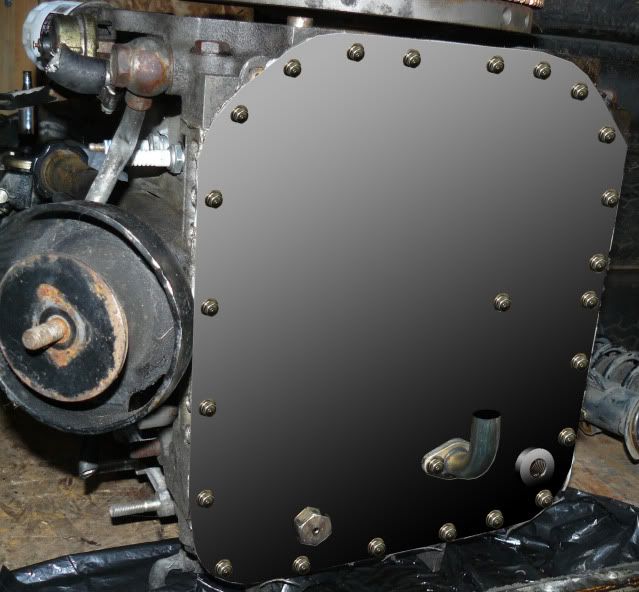S4 N/A Custom Oil pan/feed
#1
I'm doing a swap and find the 13B oil pan to be in the way. I know the pan is really just a storage/return area since it's a rotary. :P
I was wondering if I could replace the pan with a flat plate, or even remove it entirely and create a remote oil storage?
Teach me the ways of the 13B oil pickup and return!
Thank you for your time.
~DQ
I was wondering if I could replace the pan with a flat plate, or even remove it entirely and create a remote oil storage?
Teach me the ways of the 13B oil pickup and return!
Thank you for your time.
~DQ
#2
The short answer is no.
Long answer: When oil squeezes out of the bearings/drips off of the stat gears, it falls into the pan. If you did remote, you'd need a flat plate with a depression that would connect a hose to the remote source. That source would have to be lower than where the engine sits. Then you'd need a way to get oil to the pump, but the pump is covered by the plate...
See what I am getting at here?
Long answer: When oil squeezes out of the bearings/drips off of the stat gears, it falls into the pan. If you did remote, you'd need a flat plate with a depression that would connect a hose to the remote source. That source would have to be lower than where the engine sits. Then you'd need a way to get oil to the pump, but the pump is covered by the plate...
See what I am getting at here?
#3
The short answer is no.
Long answer: When oil squeezes out of the bearings/drips off of the stat gears, it falls into the pan. If you did remote, you'd need a flat plate with a depression that would connect a hose to the remote source. That source would have to be lower than where the engine sits. Then you'd need a way to get oil to the pump, but the pump is covered by the plate...
See what I am getting at here?
Long answer: When oil squeezes out of the bearings/drips off of the stat gears, it falls into the pan. If you did remote, you'd need a flat plate with a depression that would connect a hose to the remote source. That source would have to be lower than where the engine sits. Then you'd need a way to get oil to the pump, but the pump is covered by the plate...
See what I am getting at here?
its called a dry sump system. it can be done, but usually costs money.
kinda like this...
https://www.rx7club.com/20b-forum-95/20b-dry-sump-system-794420/
#4
uh.... no.
its called a dry sump system. it can be done, but usually costs money.
kinda like this...
https://www.rx7club.com/showthread.php?t=794420
its called a dry sump system. it can be done, but usually costs money.
kinda like this...
https://www.rx7club.com/showthread.php?t=794420
My reply was based on my assumption that the OP wanted to "fabricate" this.
Maybe I read his post wrong, but that is what it sounds like.
Really, I don't see the point in doing this to a rotary. Reciprocating motors have windage, the wankel does not. What benefit other than windage am I missing?
#5
Thank you for the response.
It wouldn't be difficult to place a reservoir lower than the normal pickup. I'd have to fabricate a flat plate to bolt to the bottom of the motor, with a drain into a lower, out of the way reservoir. Since the oil pickup runs out a small flanged tube, it wouldn't be difficult to extend that pickup into the reservoir.
I'm just unsure of how and where the oil returns are, and because of the process of the engine, how much oil actually returns.

I only see 4 possible returns in this diagram below, but can't quite see them on the keg above.

Edit: I'm doing this because of engine height clearances for a non-mazda swap.
It wouldn't be difficult to place a reservoir lower than the normal pickup. I'd have to fabricate a flat plate to bolt to the bottom of the motor, with a drain into a lower, out of the way reservoir. Since the oil pickup runs out a small flanged tube, it wouldn't be difficult to extend that pickup into the reservoir.
I'm just unsure of how and where the oil returns are, and because of the process of the engine, how much oil actually returns.

I only see 4 possible returns in this diagram below, but can't quite see them on the keg above.
Edit: I'm doing this because of engine height clearances for a non-mazda swap.
#6
If it is a non-mazda swap, I'd try a shallow pan. I don't have a link handy but I have seen deep and shallow pans for sale before.
You are right, there are only 4 locations for oil to return to my knowledge.
You are right, there are only 4 locations for oil to return to my knowledge.
#7
It sounds like a drysump system is what you need to pursue if the pan is that much of a problem. Even scraping one together with used parts will run you at least a grand. Your biggest expenses being the external pump, oil tank and plumbing/fittings.
I can show you some pics of a couple front covers I have that are modified for a dry sump.
About your question on how much oil returns to the pan, all of it you hope! The system moves a lot of oil a minute, I would say many gallons.
I can show you some pics of a couple front covers I have that are modified for a dry sump.
About your question on how much oil returns to the pan, all of it you hope! The system moves a lot of oil a minute, I would say many gallons.
Last edited by jgrewe; 10-02-10 at 10:58 PM.
Trending Topics
#8
My last experience was with a beat up 12a that burnt a lot of oil, so I never watched a consistent amount of oil stay in the pan. lol Thanks jgrewe& jjwalker.
I don't see why I have to use an aftermarket pump. The returns drain into the pan. The pan is just a holding area. I just run a small pan, with a drain to a reservoir and extend the stock oil pump pickup to the reservoir.
Is this in correct to think?
Anyone have further detail on the specific oil return points?
I don't see why I have to use an aftermarket pump. The returns drain into the pan. The pan is just a holding area. I just run a small pan, with a drain to a reservoir and extend the stock oil pump pickup to the reservoir.
Is this in correct to think?
Anyone have further detail on the specific oil return points?
#9
Most oil drain is through the center plate (rotor lubrication and cooling). There a lot of oiling of components in the front cover (including front main bearing drain). That's probably second. There is also a drain in the rear plate for the rear main bearing.
#10
I wish I was driving!
Joined: Dec 2001
Posts: 5,241
Likes: 84
From: BC, Canada
A is the dump from the oil pressure regulator. Rear Iron.
B is the return back to the oil pan from the rear stat bearing/ rotor bearing. Rear Iron.
C is the oil fill feed to the pan and the blow-by vent. Intermediate Iron.
D is the return for the rotor bearings, and the rotor-cooling oil from the e-shaft squirters. Intemediate Iron.
E's: The front stat gear/rotor bearing, as well as the oil pump chain all drain pretty much across the entirety of the front cover. Front cover.
F: Excessive oil pressure return. A return thats barely used, mostly there to prevent blowing the front cover off if you decide to race the engine before its warmed up.
B is the return back to the oil pan from the rear stat bearing/ rotor bearing. Rear Iron.
C is the oil fill feed to the pan and the blow-by vent. Intermediate Iron.
D is the return for the rotor bearings, and the rotor-cooling oil from the e-shaft squirters. Intemediate Iron.
E's: The front stat gear/rotor bearing, as well as the oil pump chain all drain pretty much across the entirety of the front cover. Front cover.
F: Excessive oil pressure return. A return thats barely used, mostly there to prevent blowing the front cover off if you decide to race the engine before its warmed up.
#13
I wish I was driving!
Joined: Dec 2001
Posts: 5,241
Likes: 84
From: BC, Canada
Dry sumps allow the engine to be placed lower in the chassis, allow for use of increased oil capacity, provide massively improved oil de-aeration, allow for external oil pressure adjustments, and CAN create crankcase vacuum to slightly improve sealing of the combustion chamber.
Basically, all things desirable when racing.
Basically, all things desirable when racing.
#15
My big concern would be getting the oil to cooperate and drain to where the pump pick up would be. The stock pan has no choke point restricting oil heading for the pick up. It could be done I think but you would have to be really careful on your design.
We used to run a wet/dry sump on a race car just for the added oil capacity and the more efficient external pump. It was an experiment that ended up being a waste of time and weight. The system worked great it just wasn't needed and a full dry sump wasn't allowed in the rules. It ran a stock pump in the engine as a scavenge pump, that fed the oil to a 12 quart tank. The oil tank gets the air out of the oil that can be introduced in the scavenging. The tank sent the oil to the external pump and then to the front and rear plates on the engine. There was a couple coolers in the system as well but that is easy enough to figure out.
I would try my best to keep a similar pan to stock and just make it deep or wide where ever you can. I put a Buick V6 in an Opel Manta years ago and basically cut the stock pan down to a 1" lip and built a new one that fit the cross member and suspension. I've even seen pans built with a hole through them for a steering link to pass through!
Funny story about that external pump; when we first put it on the car we didn't have an oil pressure gauge that went over 100psi. The gauge was pegged at 100 when the engine revved, we didn't think it was going very high above that. The car went to the track on Friday and I was waiting for a delivery of a higher pressure gauge. The gauge came friday afternoon and I took it to the track Sat morning. The car ran a qualifying session in the morning and we swapped gauges after that. Fire the car up with the new gauge, rev up the car, gauge says 180psi! So, the seals will hold that kind of pressure it just costs you a few HP. The pressure is set with a spring in the external pump so we swapped out to the softest spring we had and got it down to about 120psi.
We used to run a wet/dry sump on a race car just for the added oil capacity and the more efficient external pump. It was an experiment that ended up being a waste of time and weight. The system worked great it just wasn't needed and a full dry sump wasn't allowed in the rules. It ran a stock pump in the engine as a scavenge pump, that fed the oil to a 12 quart tank. The oil tank gets the air out of the oil that can be introduced in the scavenging. The tank sent the oil to the external pump and then to the front and rear plates on the engine. There was a couple coolers in the system as well but that is easy enough to figure out.
I would try my best to keep a similar pan to stock and just make it deep or wide where ever you can. I put a Buick V6 in an Opel Manta years ago and basically cut the stock pan down to a 1" lip and built a new one that fit the cross member and suspension. I've even seen pans built with a hole through them for a steering link to pass through!
Funny story about that external pump; when we first put it on the car we didn't have an oil pressure gauge that went over 100psi. The gauge was pegged at 100 when the engine revved, we didn't think it was going very high above that. The car went to the track on Friday and I was waiting for a delivery of a higher pressure gauge. The gauge came friday afternoon and I took it to the track Sat morning. The car ran a qualifying session in the morning and we swapped gauges after that. Fire the car up with the new gauge, rev up the car, gauge says 180psi! So, the seals will hold that kind of pressure it just costs you a few HP. The pressure is set with a spring in the external pump so we swapped out to the softest spring we had and got it down to about 120psi.
#16
This has been Very helpful. I'm no super scientist, I'm just trying to ensure that I can drop the motor in as low as I possibly can, retain the engine as close to factory as possible. I'm also trying to avoid cutting my transmission tunnel as I sometimes have to switch shells and really do not want to have to cut up shells over and over just to get clearances. Plus, the lower the weight, the better. The car has a steering rack behind the subframe, and since I'm very happy with this setup and how it's currently performing, I'd like to keep it as it is.
I cleaned up scathcart's image a bit, in hopes to help anyone else in the future, as well, I've included part of my plan; an early Toyota Previa oil reservoir and electric pump.
With the pan and the oil scavenge pipe removed from the 13b, the bottom of the keg is nearly perfectly flat, except for possibly "F", the excessive pressure return. There is quite a bit of cavity around the bottom of the rotors, where the oil returns are located. By placing the plate across the bottom of the keg, to replace the oil pan, a Drain/pickup hole needs to be created to allow the previa electric pump to pull the oil from the new 'shallow' pan. It would draw it up into the reservoir. The Oil pump scavenge pipe mounting point also looks to be level with the oil pan mounting surface. So the plate can be drilled to allow the exterior mounting of the pipe. This pipe will be extended to pickup oil from the bottom of the reservoir. The only issue is the "F" excess oil pressure return. Which may have to be plumbed back into the shallow pan, to the reservoir, or looped back into the scavenge pipe.
Is there flaws with this idea?
I'm aiming to place the motor very low onto the stock subframe and then create mounts to fit the subframe so as motors & shells change over the coming years, things will be a bolt in application. I don't want to have to fabricate more structural parts of the car every time I need to replace something damaged from any unexpected impacts.
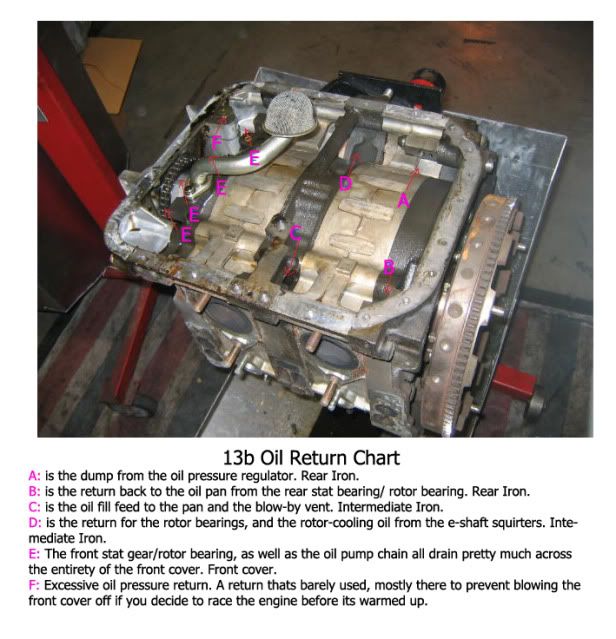
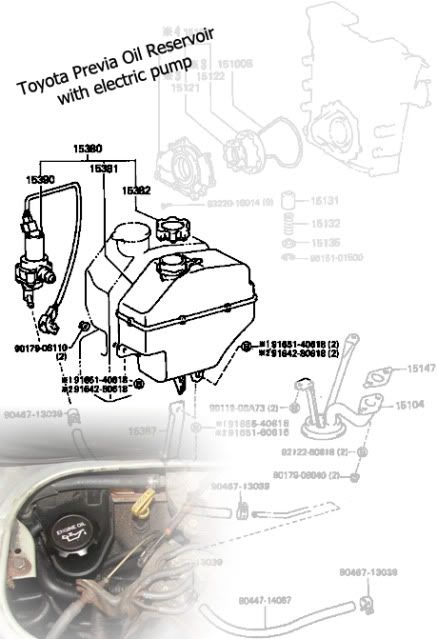
I cleaned up scathcart's image a bit, in hopes to help anyone else in the future, as well, I've included part of my plan; an early Toyota Previa oil reservoir and electric pump.
With the pan and the oil scavenge pipe removed from the 13b, the bottom of the keg is nearly perfectly flat, except for possibly "F", the excessive pressure return. There is quite a bit of cavity around the bottom of the rotors, where the oil returns are located. By placing the plate across the bottom of the keg, to replace the oil pan, a Drain/pickup hole needs to be created to allow the previa electric pump to pull the oil from the new 'shallow' pan. It would draw it up into the reservoir. The Oil pump scavenge pipe mounting point also looks to be level with the oil pan mounting surface. So the plate can be drilled to allow the exterior mounting of the pipe. This pipe will be extended to pickup oil from the bottom of the reservoir. The only issue is the "F" excess oil pressure return. Which may have to be plumbed back into the shallow pan, to the reservoir, or looped back into the scavenge pipe.
Is there flaws with this idea?
I'm aiming to place the motor very low onto the stock subframe and then create mounts to fit the subframe so as motors & shells change over the coming years, things will be a bolt in application. I don't want to have to fabricate more structural parts of the car every time I need to replace something damaged from any unexpected impacts.


#19
you still need a way for the oil to get to your reservoir. the flat cover method won't work because there is no place for the oil to return to. the front regulator needs a dump at the least which will require you to have a pan that's a few inches below the deck height of the front of the engine.
i'm just not sure why you are trying to get away with such minimal clearance. if you do need that little clearance than a dry sump is what you need. the stock pan isn't huge or bulky and could be modified for less clearance if needed(at the cost of oil capacity)
i'm just not sure why you are trying to get away with such minimal clearance. if you do need that little clearance than a dry sump is what you need. the stock pan isn't huge or bulky and could be modified for less clearance if needed(at the cost of oil capacity)
#20
you still need a way for the oil to get to your reservoir. the flat cover method won't work because there is no place for the oil to return to. the front regulator needs a dump at the least which will require you to have a pan that's a few inches below the deck height of the front of the engine.
#21
Please read below, since some people are misunderstanding the idea or just skipping reading sections.
My Question: Does anyone see any particular flaws?
Some of the answers in this thread have been either vague, or ignore the idea completely. I've written this, and created these visuals in hopes of other understanding the idea, so we can be on the same level when discussing.
Let's start from the beginning here.
Situation:
13B S4 N/A Swap into a chassis different than an FC/FB.
Problem: 3 similar issues:
1. Transmission sits to high, will cause transmission tunnel cutting.
2. Oil pan doesn't clear the subframe.
3. Motor sits to high, can't close hood.
Requirements, considerations:
No cutting to the chassis or subframe
Hypothesis for Solution:
Reduce pan height, allowing motor to sit much lower, improving transmission tunnel clearance as well as hood clearance.
Proposal:
Replacing the deep stock 13b oil pan, with a flat plate. Installing an Oil reservoir, and rerouting the oil pickup to the reservoir, while collecting and returning oil from the remaining cavity below the engine, to the new reservoir.
A simple process, the plate measured, drilled and installed. The Oil Scavenge tube is cut and lengthened into the reservoir. A Toyota Previa remote reservoir and electric oil pump are installed. The 13b's mechanical pump is retained and sucks oil from the reservoir into the regular oil system. Once passed through the system, the remaining oil is returned through the original routes to the now much flatter, smaller pan. The electric oil pump, pulls oil from the smaller pan, into the reservoir through an installed threaded drain bung.
This allows the engine to sit dramatically lower than with the original oil pan.
Reasoning:
A rotary only uses an oil pan as a catch basin/storage unit, unlike a piston engine which uses it for those purposes, as well as crankshaft lubrication.
Parts needed:
Flat sheet of steel or aluminum.
Oil Reservoir and remote electric pump from a 91 Toyota Previa.
Piping.
Some minor welding.
Visuals:

Plenty of open Cavities here around the oil return areas.
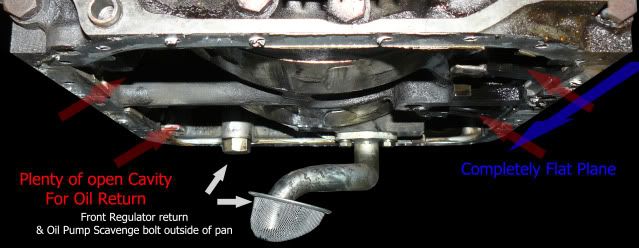
A second view to show how flat the bottom of the 13b is. Note: the oil scavenge pipe mounting surface is level and parallel to the oil pan mounting surface. Also, the front oil pressure regulator over flow nozzle mounting surface is also level and parallel to the oil pan mounting surface.

As you can see here, the front oil pressure regulator fitting and Oil scavenge tube can easily sandwich the new flat pan.
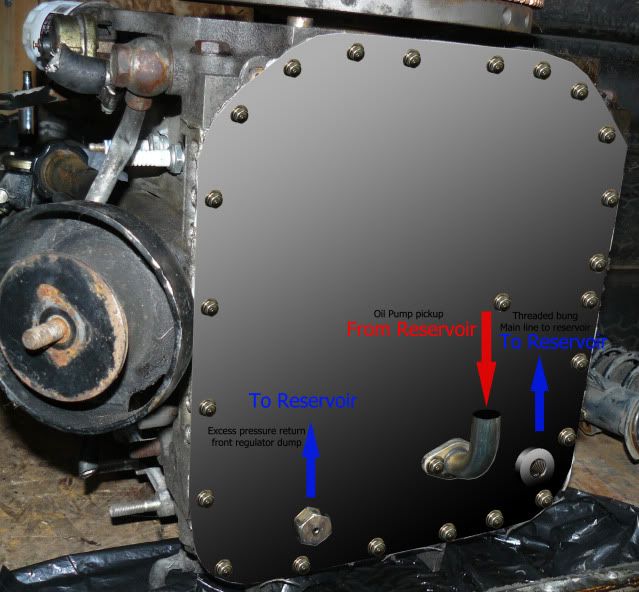
Proof of concept showing the scavenge pump piping, drain bung, and front oil pressure regulator out side of the pan. They will all need to be plumed to the reservoir.
My Question: Does anyone see any particular flaws?
Some of the answers in this thread have been either vague, or ignore the idea completely. I've written this, and created these visuals in hopes of other understanding the idea, so we can be on the same level when discussing.
Let's start from the beginning here.
Situation:
13B S4 N/A Swap into a chassis different than an FC/FB.
Problem: 3 similar issues:
1. Transmission sits to high, will cause transmission tunnel cutting.
2. Oil pan doesn't clear the subframe.
3. Motor sits to high, can't close hood.
Requirements, considerations:
No cutting to the chassis or subframe
Hypothesis for Solution:
Reduce pan height, allowing motor to sit much lower, improving transmission tunnel clearance as well as hood clearance.
Proposal:
Replacing the deep stock 13b oil pan, with a flat plate. Installing an Oil reservoir, and rerouting the oil pickup to the reservoir, while collecting and returning oil from the remaining cavity below the engine, to the new reservoir.
A simple process, the plate measured, drilled and installed. The Oil Scavenge tube is cut and lengthened into the reservoir. A Toyota Previa remote reservoir and electric oil pump are installed. The 13b's mechanical pump is retained and sucks oil from the reservoir into the regular oil system. Once passed through the system, the remaining oil is returned through the original routes to the now much flatter, smaller pan. The electric oil pump, pulls oil from the smaller pan, into the reservoir through an installed threaded drain bung.
This allows the engine to sit dramatically lower than with the original oil pan.
Reasoning:
A rotary only uses an oil pan as a catch basin/storage unit, unlike a piston engine which uses it for those purposes, as well as crankshaft lubrication.
Parts needed:
Flat sheet of steel or aluminum.
Oil Reservoir and remote electric pump from a 91 Toyota Previa.
Piping.
Some minor welding.
Visuals:

Plenty of open Cavities here around the oil return areas.

A second view to show how flat the bottom of the 13b is. Note: the oil scavenge pipe mounting surface is level and parallel to the oil pan mounting surface. Also, the front oil pressure regulator over flow nozzle mounting surface is also level and parallel to the oil pan mounting surface.

As you can see here, the front oil pressure regulator fitting and Oil scavenge tube can easily sandwich the new flat pan.

Proof of concept showing the scavenge pump piping, drain bung, and front oil pressure regulator out side of the pan. They will all need to be plumed to the reservoir.
#22
i guess you'll just have to be the first to see if the oil level above deck is going to be an issue or not with drainage.
don't think it won't accumulate a bit above the deck otherwise you will have no oil feeding into the reservoir and then on hard cornering your sump will be pulling air. so basically all your regulators will be submerged and your rotors will be holding oil because they will be below the new raised oil level.
don't think it won't accumulate a bit above the deck otherwise you will have no oil feeding into the reservoir and then on hard cornering your sump will be pulling air. so basically all your regulators will be submerged and your rotors will be holding oil because they will be below the new raised oil level.
#24
Honestly, that front relief valve is just a hex headed plug with a spring behind it. The dump from the relief valve is higher up in the cover. One should be able to recess the plug (mill off the land, some tapping for more threads may be necessary) and cut the spring accordingly. Or, source another spring. Maybe one could find a set screw type plug withe the same threads and no head. 
Just a thought. Take it out and look at it. There's not much to it.

Just a thought. Take it out and look at it. There's not much to it.
#25
I wish I was driving!
Joined: Dec 2001
Posts: 5,241
Likes: 84
From: BC, Canada
I don't really want to touch the remote reservoir idea unless I really have to.
A couple things to ponder over, tho:
1. You could easily build a new, very shallow pan that has massive kicks out each side. It'd look like a maxi-pad, with wings.
2. Parts A and F both dump directly into the pan under pressure, oil will flow out of them even if the oil level is above it. All of the other returns happen just below the centreline of the eccentric shaft. There's no reason the oil level has to remain at the "full mark" on the dipstick... let the oil fill the block higher; oil level in the pan drops while the engine is running anyway. It will place the pump drive gear in a full oil bath, and might present some amount of parasitic windage drag, but not enough to measure.
3. You can run less oil, 4 quarts instead of 5, just decrease the interval of time between oil changes, and watch the oil level.
Whats the new chassis, anyway?
A couple things to ponder over, tho:
1. You could easily build a new, very shallow pan that has massive kicks out each side. It'd look like a maxi-pad, with wings.
2. Parts A and F both dump directly into the pan under pressure, oil will flow out of them even if the oil level is above it. All of the other returns happen just below the centreline of the eccentric shaft. There's no reason the oil level has to remain at the "full mark" on the dipstick... let the oil fill the block higher; oil level in the pan drops while the engine is running anyway. It will place the pump drive gear in a full oil bath, and might present some amount of parasitic windage drag, but not enough to measure.
3. You can run less oil, 4 quarts instead of 5, just decrease the interval of time between oil changes, and watch the oil level.
Whats the new chassis, anyway?




